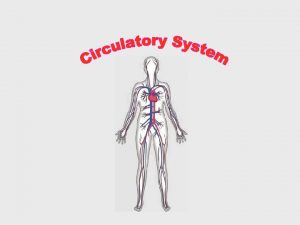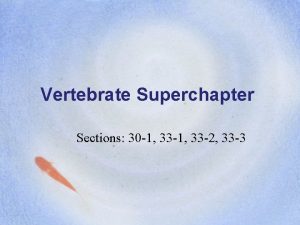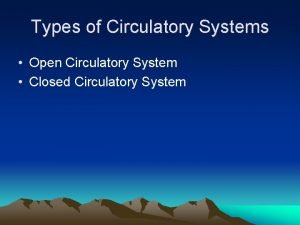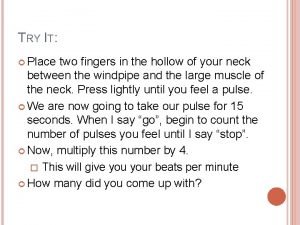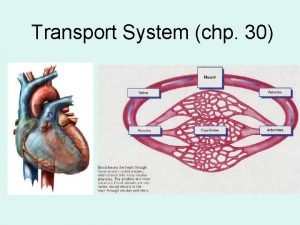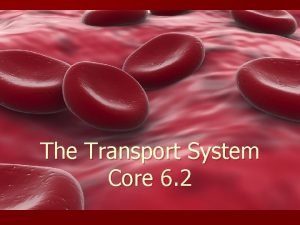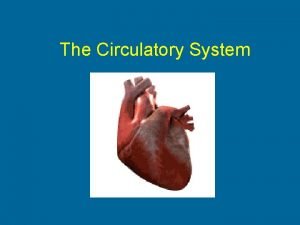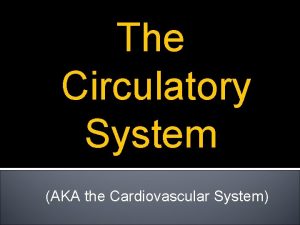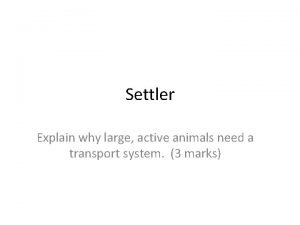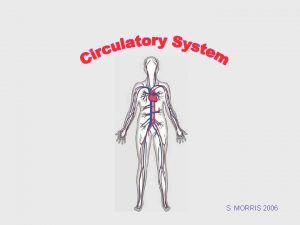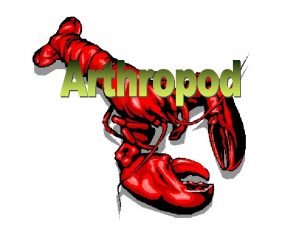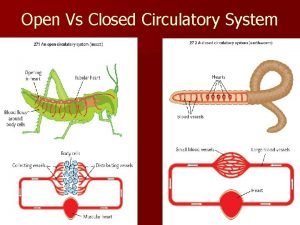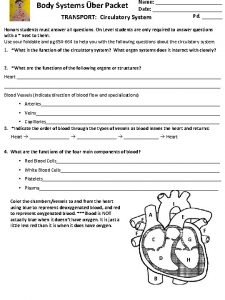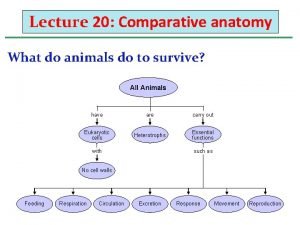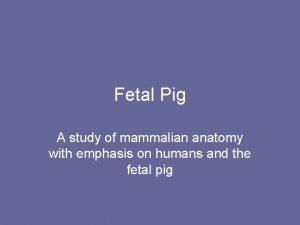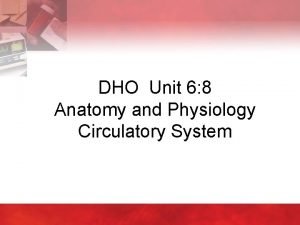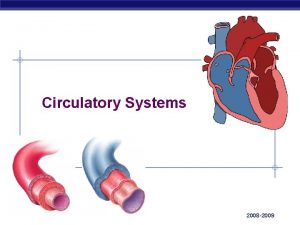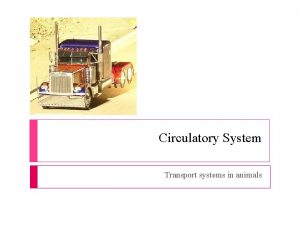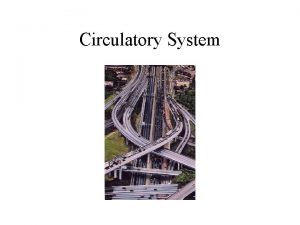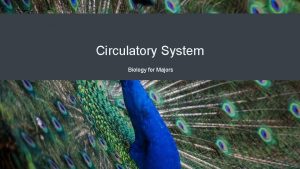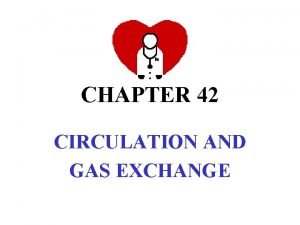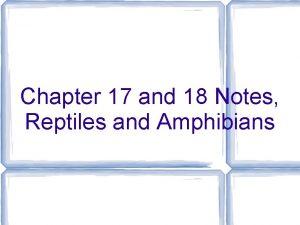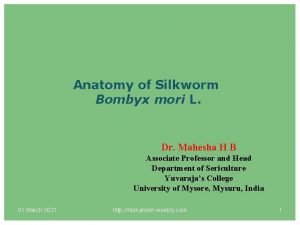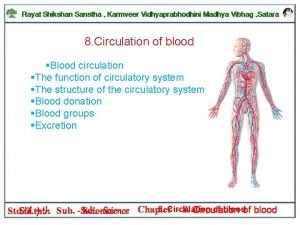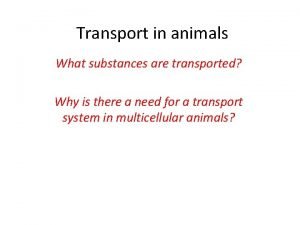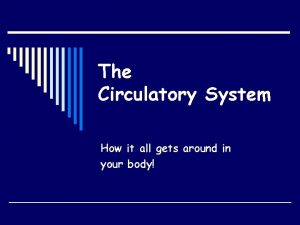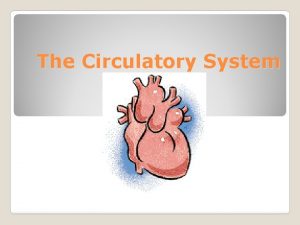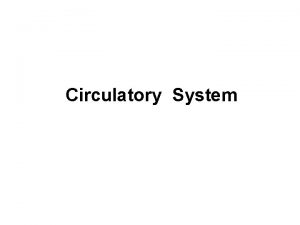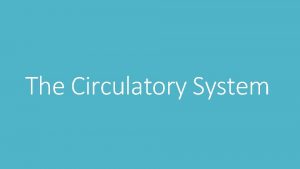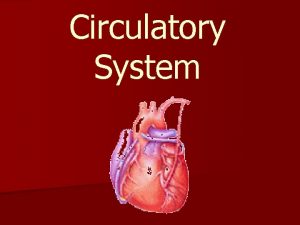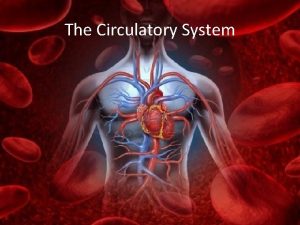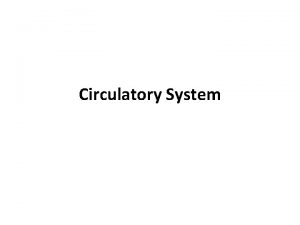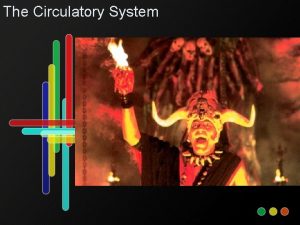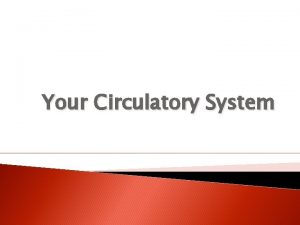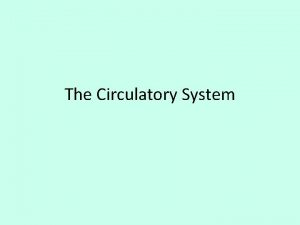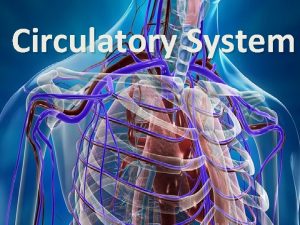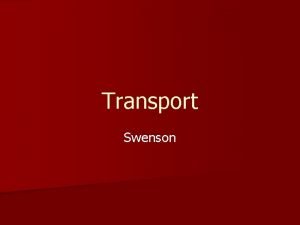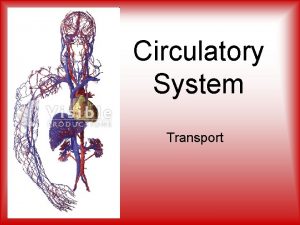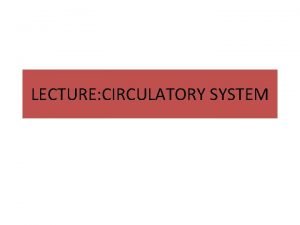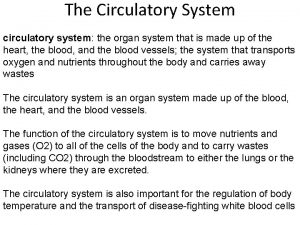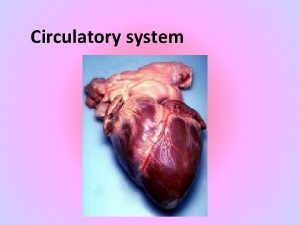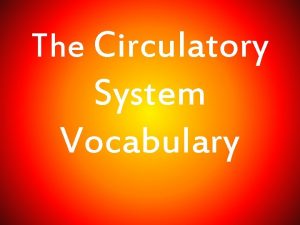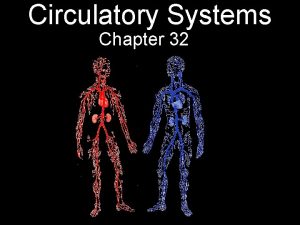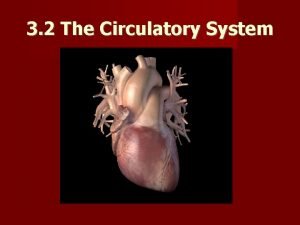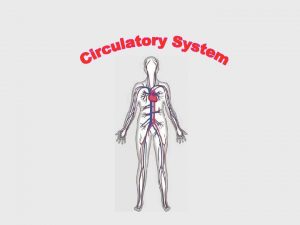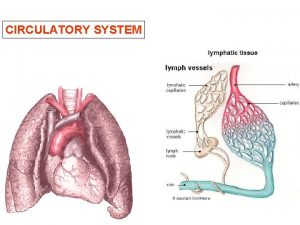The Transport System Core 6 2 Circulatory System













































- Slides: 45

The Transport System Core 6. 2

Circulatory System n Most animals have a circulatory system including a pumping device – heart – Open Circulatory System: § System may have § Organs are bathed in blood § § Ex. – Closed Circulatory System § Blood stays § Ex.


6. 2. 5 Explain the relationship between the structure and function of arteries, capillaries and veins. n Circulation in Vertebrates involves a closed system that consists of: 1. Arteries § Function: - branch into smaller vessels called § Structure: – Have a – Very – Inner diameter is small

6. 2. 5 Explain the relationship between the structure and function of arteries, capillaries and veins. 2. Capillaries: § Function: § Structure: – Walls are – in diameter – RBC’s pass through single file – to increase total crosssectional area – Results in low pressure and slower flow ( – penetration into all tissues for exchange and )

6. 2. 5 Explain the relationship between the structure and function of arteries, capillaries and veins. § Mechanisms for Exchange between Blood and Tissue: – – Materials are in cell membrane of capillary endothelial cell (endocytosis) travel across cell and – Water and dissolved molecules (not proteins) filter through clefts between adjacent endothelial cells

6. 2. 5 Explain the relationship between the structure and function of arteries, capillaries and veins. 3. Veins § Function: ; small veins called lead away from capillaries and branch into the larger veins § Structure: – ; – Smooth muscle layer is inner diameter is and

6. 2. 5 Explain the relationship between the structure and function of arteries, capillaries and veins. – Veins have to assist in moving blood up to the heart (against gravity) and also depend on squeezing from muscles


http: //www. pbs. org/wnet/redgol d/innovators/bio _harvey. html n William Harvey (1628) – English physician that was the first to accurately describe how blood is pumped by heart – published work marked the (understanding bodily processes in terms of chemistry and physics)

6. 2. 1 Draw and label a diagram of the heart showing the four chambers, associated blood vessels, valves and the route of blood through the heart.

6. 2. 2 State that the coronary arteries supply heart muscle with oxygen and nutrients. 6. 2. 3 Explain the action of the heart in terms of collecting blood, pumping blood, and opening and closing of valves. n Circulation Pathway in Humans Valves – 4 chambered heart – 2 separate pumps separated by the – One-way valves separate chambers and – Muscles squeeze the chamber in a powerful Septum

1. & 1 b. Deoxygenated blood returns to heart through 2. through 3. through to to 4. 5. To the – gas exchange takes place and blood is oxygenated 6. 9. 7. Through to 8. through to – very large artery carries oxygenated blood to the body

1 b

n Circulation outside of the heart is divided into: – Pulmonary circulation: Circulation = movement of blood

– Systemic circulation: § The heart itself is supplied with oxygen and nutrients by the.


Pulmonary circulation Right Systemic circulation Left

n Circulation in other vertebrates – are characteristic of birds and mammals § no mixing of oxygenated and deoxygenated blood

– Fish have a § Systemic circulation under very low pressure, blood moves sluggishly

– Amphibians and reptiles have – 2 atria and 1 ventricle § Oxygenated and deoxygenated blood § show beginning of development of septum (reduces mixing)


6. 2. 4 Outline the control of the heartbeat in terms of myogenic muscle contraction, the role of the pacemaker, nerves, the medulla of the brain and epinephrine (adrenaline). n Contraction of the heart – Cardiac cells tend to § Contraction of one heart cell stimulates – Contraction of atria is initiated by wave of contraction passes through atria to impulse transmitted to and wave continues

6. 2. 4 Outline the control of the heartbeat in terms of myogenic muscle contraction, the role of the pacemaker, nerves, the medulla of the brain and epinephrine (adrenaline). § When the network in the atria contracts, blood in the atria flows into the ventricles. § When the ventricles contract, blood flows out of the heart.

– Heartbeat is initiated by the § Pacemaker is located in the § The impulse spreads from the pacemaker to a network of fibers in the atria. Sinoatrial (SA) node

– The impulse is picked up by a bundle of fibers called the and carried to the network of fibers in the ventricles. § AV node is located on septum between atria § – fibers that extend from AV node into walls of ventricles § further branch into all parts of ventricular muscle Bundle of His Atrioventricular (AV) node Purkinje fibers

n Cardiac muscle cells are electrically coupled by – Intercalated disks consist of desmosomes and gap junctions – Desmosomes are made of intercellular cement and protein – Gap junctions allow ions to pass through to stimulate the neighboring cell

n How is the pacemaker regulated? – Nervous control of heart is a – Heart receives impulses from a control center in the , via 2 nerves § One nerve , the other (antagonistic – opposite)

– (Adrenaline), which is produced by the adrenal glands, travels through the bloodstream and Which response is caused by the release of epinephrine? Why would the heart rate need to increase?

n Cardiac Cycle – Heart chambers alternate between – Contraction phase is called , and relaxation phase is called – Heart sounds heard with a stethoscope are caused by – Sound pattern is “lub-dup, lub-dup” – First heart sound (“lub”) is created by closing of AV valves – Second sound (“dup”) created by closing of semilunar valves

– Heart murmers – occur when – Electrocardiograms –

http: //4. bp. blogspot. com/_5 Nslwo 9 F 6 b. I/S_EUKcs 4 DI/AAAAAg 4/5 f 0 VSazrc. N 4/s 1600/ECG+trace+%26+basics. jpg

n Blood Pressure and Rate of Flow – During systole, heart – During diastole, heart

– is measured to record the regular cycle of pressure in the arteries as the heart contracts § Usually measured in with a § Average pressure for young adult male is

– Blood pressure varies by location in body and § Resulting gradient of pressure causes fluids move from regions of – § Differences in systolic and diastolic pressures diminish with § By the time blood reaches capillaries the flow is (rather than surging as in the arteries)

§ Pressure continually drops through arterioles and capillaries and is the lowest in the veins closest to the heart § Rate of flow – Highest in – Lowest in in – Increases again in Why does rate of flow in the capillaries need to be low?

6. 2. 6 State that blood is composed of plasma, erythrocytes, leucocytes (phagocytes and lymphocytes) and platelets. 6. 2. 7 State that the following are transported by blood: nutrients, oxygen, carbon dioxide, hormones, antibodies, urea and heat. n Composition of blood 1. Plasma : § liquid matrix constituting § Plasma is with a variety of dissolved substances:

– organic anions (Cl-, HCO 3 -) (Na+, Ca+2, K+, Mg+2) and – (fibrinogen, albumins, and globulins – important for osmotic pressure in plasma, help to transport substances, blood clotting) – (glucose, fats, phospholipids, amino acids, lactic acid, cholesterol) – – urea, ammonia and uric acid – – regulatory chemicals – 3 gases found in small amounts – – – distribution to all tissues

2. White Blood Cells § Five major types: § Fight infections

§ Monocytes and neutrophils are § Eosinophils § Basophils release – causes (increased blood flow to injured site) – part of inflammatory response

§ Lymphocytes – – part of specific immune response resulting from exposure to an (foreign substance in body) – (globulin proteins) to destroy antigen – specifically fight antigen that stimulates production

3. Red Blood Cells – § § Approximately § Live approximately destroyed by liver and spleen § Formed in bones, skull, ribs, and pelvis) § Filled with gives red color) *Some animals (mollusks and arthropods) have – contains Cu instead of Fe – dissolved in plasma not in cells – (in long (carries oxygen,

4. Platelets – play a part in the

n Whole blood – n Blood plasma – n Blood serum –

n Blood – clotting converts to comes out of solution and (forms a hard lump or clot)
 Circularory system
Circularory system Tiny air sacs at the end of the bronchioles
Tiny air sacs at the end of the bronchioles Circulatory system and respiratory system work together
Circulatory system and respiratory system work together Primary vs secondary active transport
Primary vs secondary active transport Active transport
Active transport Now answer the following questions
Now answer the following questions Passive transport vs active transport venn diagram
Passive transport vs active transport venn diagram Pinocytosis vs phagocytosis
Pinocytosis vs phagocytosis Primary active transport vs secondary active transport
Primary active transport vs secondary active transport Bioflix activity membrane transport active transport
Bioflix activity membrane transport active transport Passive trnasport
Passive trnasport Isotonic in biology
Isotonic in biology Circulatory system steps in order
Circulatory system steps in order Section 30-1 the chordates answer key
Section 30-1 the chordates answer key Heart fish
Heart fish Is circulatory open or closed in clams
Is circulatory open or closed in clams Sheep circulatory system
Sheep circulatory system Function of the circulatory system
Function of the circulatory system Closed circulatory system
Closed circulatory system Jobs of circulatory system
Jobs of circulatory system 3 parts of the circulatory system
3 parts of the circulatory system Double circulatory system
Double circulatory system How circulatory system work
How circulatory system work What makes up the cardiovascular system
What makes up the cardiovascular system Gas exchange lungs
Gas exchange lungs Single vs double circulatory system
Single vs double circulatory system Arthropods respiratory system
Arthropods respiratory system Crustaceans characteristics
Crustaceans characteristics Open circulatory system vs closed
Open circulatory system vs closed Circulatory system foldable
Circulatory system foldable Invertebrate circulatory system
Invertebrate circulatory system Fetal pig taxonomy
Fetal pig taxonomy Unit 6:8 circulatory system
Unit 6:8 circulatory system Open circulatory system
Open circulatory system Invertebrate circulatory system
Invertebrate circulatory system Circulatory system function
Circulatory system function Main function of the circulatory system
Main function of the circulatory system Arthropods circulatory system
Arthropods circulatory system Difference between open and closed circulatory system
Difference between open and closed circulatory system Chapter 34 section 2 the respiratory system
Chapter 34 section 2 the respiratory system Vomeronasal organ snakes
Vomeronasal organ snakes Excretory system of silkworm
Excretory system of silkworm Function of the circulatory system
Function of the circulatory system Transport substances in animals
Transport substances in animals Circulatory system interactions with other systems
Circulatory system interactions with other systems Function a
Function a












